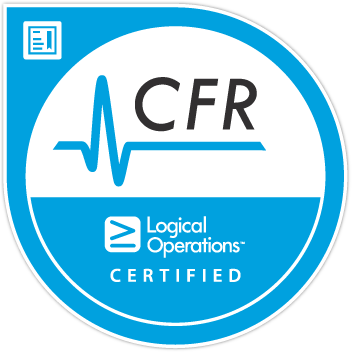I am happy to share that I have passed the CyberSec First Responder (Exam CFR-210) certification!
The CyberSec First Responder (Exam CFR-210) certification is designed for security professionals who are interested in pursuing a career in the defensive aspect of security. For example, to work on tasks such as to perform an analysis of threats, to design a secure network environment, to defend a network or to investigate a security incident.

Check out the official website of the CyberSec First Responder (Exam CFR-210) certification to read more about their official introduction.
My Background before taking the exams
My current job as a penetration tester is focused on the offensive aspect of security, which is also the first area where I started my career in the information security industry. Now, I still enjoy the offensive side of security very much.
As a penetration tester, it is almost mandatory to have the Offensive Security Certified Professional (OSCP) certification, so if you like the offensive side of security, go for their Penetration Testing with Kali (PWK) course and “try harder”, the examination is hands-on and the number of things you get to learn from it is enormous. If you’re interested, check out My OSCP / PWK Course Review where I share my OSCP journey and also some tips to pass the exams and also to get started more effectively.
I have been working in the IT industry for over 5 years now, of which over 2 years were in the information security industry. I hold the following security certifications before I passed my CyberSec First Responder (Exam CFR-210) certification: OSCP, CREST CRT, CPSA, CEH.
For Learning and Gaining Exposure to Different Aspect of Security
What about the other aspects of security besides penetration testing? During my course of study at the National University of Singapore (NUS) as a candidate for Master of Computing (Infocomm Security), I was fortunate to meet many awesome friends who also work in the information security industry. They are all specialised and experienced in their own domain in the field of information security. Hence, it was very fun and interesting to chat with them and discuss the kind of things that they encountered at work. It makes me curious and keen to learn more. We took up many classes together and along the way, we were frequently impressed by the vast diversity of knowledge in the domain of information security.

All these encounters made me felt that what we currently know is only the tip of an iceberg, and every day is an opportunity to learn something new. It makes me curious about many things and wants to learn more about each of them to expand my horizons in the information security industry.
Why CFR?
When I first came to know about the CFR certification, I find it very interesting! Here are three reasons at the back of my mind now:
Reason #1: Because I felt that the certification will become well recognised soon.
Although not many people in Singapore know about this certification, I believe it will quickly grow in its popularity in the next few years. As of 2017, it was already well recognised in the United States (US):
Logical Operations is pleased to announce that the United States Department of Defense (DoD) has approved the CyberSec First Responder™ (CFR-210) cyber security certification program as DoD Directive 8570 compliant. CFR is now an approved Baseline Certification for the CSSP Analyst and CSSP Incident Responder categories, and verifies the skills necessary to perform these job functions.
I also see how Logical Operations and OUTCERT are promoting this certification. I always feel that a certification is only useful if its standard is being maintained. It have to be of good quality, or it will not be worth having it.
The message that I have gotten from the creators of this certification is that they are putting in a lot of effort to promote it and to improve the quality of their material.

Reason #2: Because I want to learn more about cyber defense
Many people that I have spoken to, told me that learning cyber defense skills and techniques is useless to me and my career as a penetration tester. I do not agree. It is always good to learn about different stuff, gain different skills, especially when both areas are closely knitted.
A good cyber defender should possess the knowledge to identify attacks. What if you’re an attacker yourself and you know exactly what the attacker is trying to do while you’re defending the network? And vice versa.
All these would become even more interesting if you look at it from the perspective of Red Team versus Blue Team, where both teams are constantly learning new things from each other and improve their game.
Furthermore, I am interested in it, so why not?
All these encounters made me felt that what we currently know is only the tip of an iceberg, and every day is an opportunity to learn something new. It makes me curious about many things and wants to learn more about each of them to expand my horizons in the information security industry.
Reason #3: Because I can
Yes, just because I love to learn. This is my learning journey, so I get to learn anything I want and share about it. I personally enjoyed the learning because there are quite a few things which I didn’t know previously, or I know about it but do not know why or how things are like this.
I felt that I learn a lot of things when I go in-depth and explore various things that I don’t previously know. The study materials of CFR consist of many different domains across the defensive aspect of security.
Tested Domains for the CFR-210 Exam
| Name of Domain | Weightage in the Exams |
| 1.0 Threat Landscape | 25% |
| 2.0 Passive Data-Driven Analysis | 27% |
| 3.0 Active Asset and Network Analysis | 28% |
| 4.0 Incident Response Lifecycle | 20% |
| 100% |
If you’re interested, check out the exam blueprint for the list of the breakdown in each domain.
CFR-210 Exam Format
The certification examination is 2 hours (120 minutes) and there are 100 questions to be answered.
The 100 questions consist of multiple choice questions and questions that you need to choose multiple responses.
In Singapore, you can take the examination at one of the PearsonVUE exam centers across the island.
How to Study for CFR-210 Exam?
After you have signed up for the course, you can download a PDF e-book that consists of over 300 pages.
The content of the book is exactly the things outlined in the exam blueprint. To be honest, I find that the content of the book is detailed and in-depth for good learning.
I tend to study more than what was covered in the book by searching for examples online and “digress” for a few hours then come back to the book. However, to pass the exam, you just need to study what is covered in the book.
The book will sometimes expect you to run some commands on your machine, so follow along if you have not done them before.
That’s right! Self-studying should be more than enough to pass the CFR-210 exam.

Conclusion – is it worth it?
Honestly, I felt that the CyberSec First Responder (Exam CFR-210) certification is worth it, given that the study material is good quality and in-depth. It will prove to be useful for folks who want to pursue a career on the defensive side of information security.
At least for me, I felt that I learnt a bunch of stuff while taking it!
If you have also taken the CyberSec First Responder (Exam CFR-210) certification and have something more to share, please leave a comment below!
If you have not taken the exam but intending to take it sometime soon, good luck and have fun!
Niko
April 5, 2019Thank you for sharing Kongwenbin!!!
Best,
Niko
kongwenbin
April 21, 2019Hi Niko, great to know that my review is useful to you. Cheers! 😉
Asogan
April 16, 2019Where can i buy the BOOK to study on the CFR-210
kongwenbin
April 21, 2019Hi Asogan, you can try OUTCERT’s official website, I signed up for a package back then and it includes the study material and exam voucher.
Sofia
April 25, 2021Hi Wen Bin, did u sign up with any training providers?
Sofia
April 25, 2021I looked up the OUTCERT website. How does the exam voucher works? How is the exam conducted?
kongwenbin
August 17, 2021Hi Sofia, the exam voucher came with the package I get from OUTCERT, it contains a key that you can submit to the PearsonVUE exam booking website if I remember correctly. The exam is held in a physical exam centre, where you have to go in person to register and use the computers provided over there. In Singapore, you can take the examination at one of the PearsonVUE exam centres across the island.
kongwenbin
August 17, 2021Hi Sofia, I signed up with OUTCERT directly back then, never went through any training providers here in Singapore.
Jerry L
March 11, 2022I took the CyberSec First Responder 410 beta and passed. I took it because it is a free test and I wanted to see what it measured. In fairness, I have passed the Security+, CISM, CRISC, and CISSP tests; the CISSP by reading an old Harris book the night before. I passed the FITSI-O without studying and I did not study for this test. It is an excellent measurement of basic Cyber Incident Response and I was surprised to discover that one of my Incident Handlers took the test and failed. I need to look closer at their qualifications and training.
kongwenbin
December 14, 2022Hi Jerry, thanks for sharing about your attempt for CyberSec First Responder 410 beta. I think the certification body is working hard in creating new courses that provide some challenges to the security professionals! 🙂